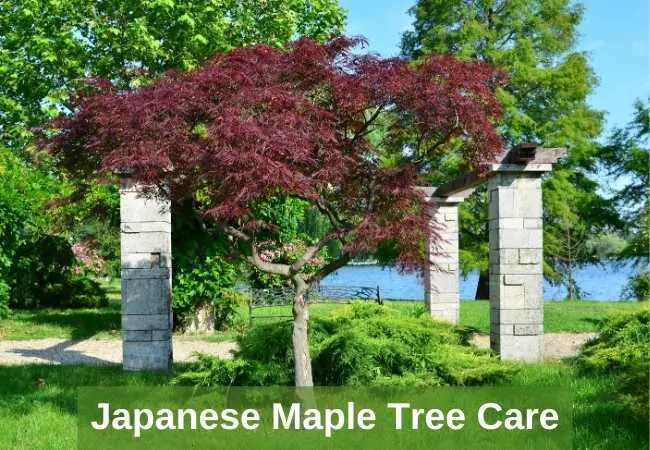Japanese Maple Tree Care

Japanese Maple tree care that will help you get beautiful and healthy trees. Japanese Maple trees can be wonderful long-term garden plants. If you plant them properly and give them a little aftercare, they will be a delight season after season. You can also plant them together with Holly, Azalea, and hemlock.
Japanese Maple Tree Varieties
There are different varieties of Japanese Maple trees to choose from depending on the look that you want. The varieties depending on leaf form which can range from delicately divided leaves to large full leaves.
The leaf color where the leaves change into different colors through different seasons to include red, orange, pink, white, as well as yellow and green variegations.
The trees also differ depending on how they branch out. Some are upright while others are horizontal branches. Japanese Maples range in height from as low as 5 feet to as high as 25 feet.
The common varieties include Coral Bank, Ozakazuki, Bloodgood, Emperor, Purple Ghost, and Sherwood Flame.
Japanese Maple trees do well in zones 5 to 8. When grown in hotter regions, the tree’s leaves get sun scorched and die. In colder regions, the branches die during winter. In both cases, the trunks might sprout after the harsh weather is gone.
Japanese Maple Tree Care
Growing Japanese Maple Trees in Containers
Japanese maples also make perfect plants for pots and containers. Container grown Japanese Maple trees is perfect for decorating balconies, courtyards, and patios. If you intend to grow them in containers, go for the varieties that don’t get too big.
Choose a container that enhances the type and character of the tree and also one that is in line with your garden theme.
The container also needs to be considerably bigger than the nursery pot. This will give the plant enough room to grow and develop over the next few years.
The large size will also allow it to hold enough soil to keep the plants stable. Enough soil will also help the plant to have access to enough water.
Put a layer of broken rocks at the bottom of the container to cover the drainage holes as well as prevent them from getting blocked. Partially fill the pot with compost mix. Carefully remove the Japanese Maple tree from its nursery pot and set it inside the container.
Position it properly and fill around it with the compost mix. Firm down the compost with your fingertips around the plant.
Planting In the Ground
Follow the same technique when planting in the open ground. Prepare the soil well by adding plenty of compost. Dig a hole that is larger than the nursery pot. Remove the plant and position it in the hole.
Fill the sides with soil and firm it down to make sure the roots are in contact with the soil.
Watering
Water thoroughly and keep watering during the first growing season until the plant is well-established. Water the plant at least once every week. During hot weather, you should water them more often.
Japanese Maple trees don’t like to sit in water. They will not do well if planted in a swampy or marshy area.
They also hate being too dry at the root, therefore if you plant them in shallow chalky soils they will struggle.
When they’re too dry, the leaves get brown tips. If they don’t get water in time, the whole leaf goes crispy and dies off.
Fertilizing
Fertilize your Japanese Maple trees to get great results. Renew your mulch every year during spring.
You should apply a handful of tree fertilizer to the trees during the growing season. Scatter the fertilizer at the base and mix it in with the soil.
Young Japanese Maple trees also benefit from being fed with liquid fertilizer. Apply the fertilizer during late spring and early summer.
If you’re growing your Japanese Maple trees in containers, it’s advisable to feed them with liquid fertilizers. Apply the fertilizer once during the growing months.
It is important to follow the directions on the liquid fertilizer you are using to avoid burning the tree’s foliage.
Light
The majority of the Japanese Maple tree varieties are happiest when grown in an area with some shade. However, the red leaf varieties require direct sunlight to get the deep foliage color. If the shade is too much, the leaves become dull and the autumn color is poor.
The variegated types and the varieties with thin delicate leaves do well in shadier conditions. When choosing a location for growing your Japanese maple trees, keep in mind that the delicate leaves can get damaged easily.
Pruning
Japanese Maple trees don’t require too much pruning and trimming. This especially true if you are growing them in the ground.
However, if you notice that the plants have long shoots or branches, you can trim them back to promote denser growth. When trimming the trees, cut just above the branch just above a pair of buds.
If you’re growing your tree in containers, regular trimming may be necessary to limit them within the available space.
Bonsai Japanese Maple Trees
All types of Japanese Maple trees can be trained into bonsai trees. However, the process of training bonsai trees is challenging and most people just prefer to buy already trained trees.
Also training a bonsai tree requires patience in addition to the skills. The training enhances the beauty of the trees. The mature bonsai Japanese Maple trees are conversation starters.
Check this post on how to grow Climbing Roses, or this one on Clematis growing and care.
Final Thoughts
Whether you decide to grow the upright or the cascading varieties, you should include these beautiful trees in your garden. If you have limited space, try growing them in containers.
They look amazing with their differently colored foliage. Please share this post on Japanese Maple tree care and also follow me on Pinterest for awesome posts on plants and flowers.






